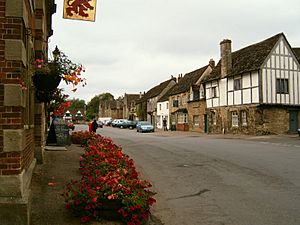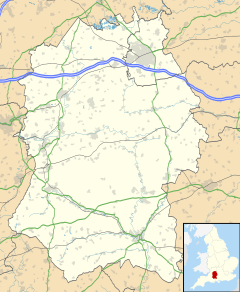Lacock facts for kids
Quick facts for kids Lacock |
|
|---|---|
 High Street, Lacock |
|
| Population | 1,159 (in 2011) |
| OS grid reference | ST915685 |
| Unitary authority |
|
| Ceremonial county | |
| Region | |
| Country | England |
| Sovereign state | United Kingdom |
| Post town | CHIPPENHAM |
| Postcode district | SN15 |
| Dialling code | 01249 |
| Police | Wiltshire |
| Fire | Wiltshire |
| Ambulance | Great Western |
| EU Parliament | South West England |
| UK Parliament |
|
Lacock is a charming village in Wiltshire, England. It's about 5 kilometers (3 miles) south of the town of Chippenham. Most of the village belongs to the National Trust, a group that protects special places. People love to visit Lacock because it looks so old and untouched.
The area around Lacock, called its parish, includes other small places like Bowden Hill, Notton, and Reybridge. The River Avon also flows through this area. Every year, Lacock holds a fun scarecrow festival. This event is popular with visitors and helps raise money for Lacock Primary School.
Contents
History of Lacock
Lacock is a very old village. It was first mentioned in a famous book called the Domesday Book. This book was written almost 1,000 years ago! Back then, Lacock had about 160 to 190 people, two mills, and even a vineyard.
Lacock Abbey and the Wool Trade
Lacock Abbey was started in 1232 by a noblewoman named Ela, Countess of Salisbury. The village and its lands were given to the Abbey. Lacock became a busy place for making wool during the Middle Ages. This was a time when wool was very important. For a long time, the only ways to cross the River Avon were at Reybridge or a special shallow area for packhorses.
Later, when monasteries were closed down in England, Lacock Abbey and the village were sold. They eventually came into the hands of the Talbot family. A famous person from this family was Henry Fox Talbot. He was a pioneer in photography and lived in Lacock from 1800 to 1877.
In 1944, the Lacock estate, including the Abbey and the village, was given to the National Trust. This gift helps make sure the village stays special for everyone to enjoy. Today, Lacock has a few places to eat and several shops on its High Street.
Famous Buildings in Lacock
Many of the houses in Lacock village are very old, some built in the 1700s or even earlier. Some of the most important buildings are:
- Lacock Abbey: This historic building was once a monastery.
- St Cyriac's Church: This church dates back to the 1300s.
- Tithe Barn: A large barn from the 1300s where farmers used to store a part of their crops as payment.
These three buildings are considered "Grade I listed," which means they are very important and protected. Other important buildings in the area include Bewley Court and Bowden Park.
Other Notable Structures
There are also four "Grade II* listed" structures in Lacock. These are also very important, but not quite as much as Grade I. They include:
- The Sign of the Angel: An old house from the late 1400s, now an inn.
- Village Cross: A medieval cross that was moved outside the school in the late 1800s.
- Bridges over the Avon: A pair of old bridges that cross the River Avon.
- Conduit House: A 1500s building that was part of the Abbey's water system.
Next to the tithe barn, you can see a small old "lock-up" from the late 1700s. This was like a tiny jail where people who broke minor rules were held.
Ray Mill House and Lackham House
North of the village, you'll find Ray Mill House. It was built around 1860 in an Italian style. Since 1996, it has been a home for Camilla Parker Bowles, who is now Queen Camilla.
Further north is Lackham House, a large country house built between 1791 and 1796. It has a grand Palladian style.
Education in Lacock
A school was built in Lacock village in 1824 by Henry Fox Talbot. It could hold 100 students. More classrooms were added later. By 1858, about 120 students attended the school. The school was rebuilt in 1859, again paid for by the Talbot family. It was designed for 220 students and 80 younger children.
Over time, the number of students went down. In the early 1960s, older students started going to school in Chippenham instead.
Since 1946, there has been an agricultural college at the Lackham estate, north of the village. This college has a 400-acre farm and is now part of Wiltshire College.
Lacock as a Filming Location
Lacock village is so beautiful and old-fashioned that it's often used for movies and TV shows!
- It was featured in the 1995 BBC TV series Pride and Prejudice.
- It also appeared in the 2007 BBC show Cranford.
- Fans of Harry Potter might recognize parts of Lacock from Harry Potter and the Philosopher's Stone and Harry Potter and the Half-Blood Prince.
- It was also used for the Harry Potter spin-off film Fantastic Beasts: The Crimes of Grindelwald.
- In 2012, the fantasy adventure movie Mariah Mundi and the Midas Box filmed scenes here.
More recently, Lacock has been seen in:
- An episode of the TV series Downton Abbey in 2015, where it looked like a 1920s livestock market.
- Two episodes of the Wolf Hall series, based on historical novels.
- The 2017 film Beauty and the Beast.
- The 2019 Downton Abbey movie, which included a royal parade scene.
Famous People from Lacock
Lacock was the childhood home of Zoe Sugg and Joe Sugg. They are siblings who are both very popular on YouTube.
See also
 In Spanish: Lacock para niños
In Spanish: Lacock para niños



